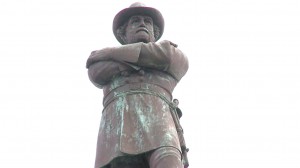N.O. City Council votes to remove Confederate era statues
13th July 2015 · 0 Comments
By Mason Harrison
Contributing Writer
i need an installment loan with no credit check
Regular trips to New Orleans helped to define childhood for Professor Adrienne Dixson, now an academic at the flagship campus of the University of Illinois at Urbana-Champagne where she teaches how the politics of race and education often mix. But Dixson, as a child, was still light years away from fully grasping racial politics, let alone able to mold collegiate minds on a topic that remains raw for many people.
“I remember coming to New Orleans as a child and seeing those Confederate monuments and thinking, ‘That’s strange,’ because it didn’t make sense and I couldn’t understand why they were there,” she said. Her befuddlement, then, is shared by the son of a local political figure, now. “I remember my son asking me, ‘Daddy who’s that?’ I said son that’s Gen. Robert E. Lee. ‘Who’s that?’ he’d ask. Well, he fought in the Civil War for the Confederacy. ‘But didn’t we win that war?’ Well, we haven’t won it all the way.”
Councilman Jason Williams said his son shouldn’t have to confront new installment loan companies an image that reminds him of a time when his skin could land him in shackles. His remarks came during a July 9 City Council meeting where members were asked to take up a motion to begin the process of removing monuments honoring Gen. Lee, P.G.T. Beauregard, Jefferson Davis and a highly controversial obelisk dedicated to the White League, followed by renaming Jefferson Davis Parkway to honor Xavier University president, Dr. Norman Francis.
The council explored details of the proposal — at the urging of Mayor Mitch Landrieu who spoke before the council calling for the changes — alongside a heated debate over the meaning of symbols, the history of the Confederacy and charges of “Black supremacy” that dominated the council meeting for hours.
One man testified to the engineering skills of Robert E. Lee, citing how, as a military man, Lee’s talent for controlling the movement of vast bodies of water would become beneficial to Louisiana, arguing that removing the Lee Circle monument would dishonor his contributions to New Orleans. Williams said, “Yes, he personal loans based on credit score was a great engineer and considered one of the great military minds of his day, but he isn’t wearing an engineering uniform he’s wearing his Confederate uniform [as depicted in the monument].”Joey Cargol, a supporter of maintaining the Confederate monuments, said the debate was not about slavery, or keeping anyone in bondage, or, for that matter, about white supremacy. His remarks garnered shouts to the contrary from Black residents eager to see the doing away with what some see as racist symbols. “They are about white supremacy,” said one person. “No they’re not,” Cargol said. “You can say whatever you want. You can say it’s about white supremacy or Black supremacy, it’s about history.”
He said, “We don’t get to pick what history is. We are a gumbo and we can’t change who we are,” contending that no matter how painful the past might be, it is more important not to discard it. “Taking down these monuments will accomplish nothing. If we forget history then we are doomed to repeat it.”
But passions were equally enflamed on the side of uprooting memories of the Confederacy, with some asking the council to go further and rename streets, schools and anything else bearing the name of Confederate icons, charging that no symbol of Nazi Germany would be allowed to stand in New Orleans. “Put up a swastika and let’s see how fast the Jews will teach you how to take it down,” said Rudy Mills, Sr. But that analogy ran cold among the monuments’ most avid supporters. “The Confederacy never executed anyone,” yelled one man, a statement that produced gasps from several people.
In the waning moments of the hearing, opponents took to song to urge the council to vote against the monuments, with activist Pat Bryant leading the audience in a muted rendition of “Oh, Freedom,” a post-Civil War freedom song often used during the Civil Rights Movement and other political protests, ending his recitation with the words, “And before I’d be a slave, I’ll be buried in my grave.”
The council passed the motion unanimously.
This article originally published in the July 13, 2015 print edition of The Louisiana Weekly newspaper.





